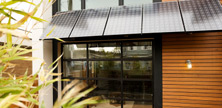Solar Electricity

Generate cheap, green electricity from sunlight
Solar electricity systems capture the sun's energy using photovoltaic (PV) cells. The cells convert the sunlight into electricity, which can be used to run household appliances and lighting.
PV cells don't need direct sunlight to work - you can still generate some electricity on a cloudy day.
- How do photovoltaic (PV) cells work?
- The benefits of solar electricity
How do photovoltaic (PV) cells work?
PV cells are panels you can attach to your roof or walls. Each cell is made from one or two layers of semiconducting material, usually silicon. When light shines on the cell it creates an electric field across the layers. The stronger the sunshine, the more electricity is produced.
PV cells come in a variety of shapes and colours, from grey "solar tiles" that look like roof tiles to panels and transparent cells that you can use on conservatories and glass.
The strength of a PV cell is measured in kilowatt peak (kWp) - that's the amount of energy the cell generates in full sunlight.
The benefits of solar electricity
- Cut your carbon footprint: solar electricity is green, renewable energy and doesn't release any harmful carbon dioxide or other pollutants. A typical home PV system could save around 1.2 tonnes of carbon dioxide per year - that's almost 30 tonnes over its lifetime.
- Cut your electricity bills: sunlight is free, so once you've paid for the initial installation your electricity costs will be greatly reduced. A typical home PV system can produce 50% of the electricity a household uses in a year.
- Sell electricity back to the Grid: if your system is producing more electricity than you need, or when you can't use it, someone else can use it - and you could make a bit of money.
Store electricity for a cloudy day: if your home isn't connected to the national grid you can store excess electricity in batteries to use when you need it. |

